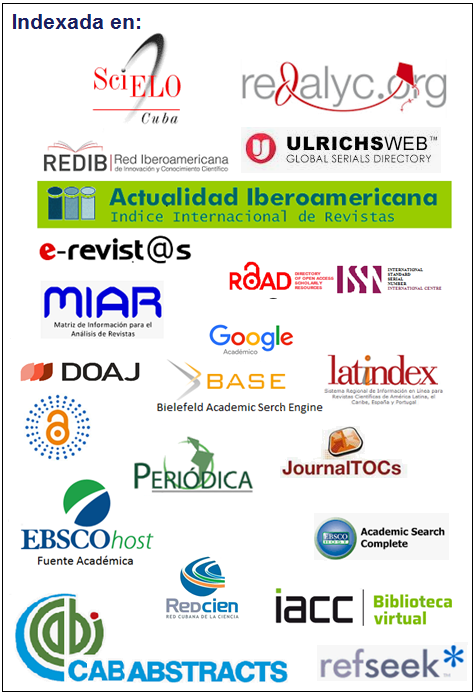Effect of welding current on chemical composition and microstructure of Fe-Cr-C deposits obtained by SMAW for abrasive and erosive wear conditions
Keywords:
welding current, microstructure, Fe-Cr-C deposits, SMAW.Abstract
The effect of welding current on the chemical composition and microstructure of Fe-Cr-C deposits obtained by SMAW and used for working under abrasive and erosive wear conditions was evaluated. Chemical composition of the deposit without dilution was determined and microstructure of the deposits was obtained with and without dissolution. The dilution coefficient was determined based on the geometry of the deposits and the chemical composition of the deposits for different welding currents based on it. It is concluded that all the deposits respond to the AWS EFeCr-A4 designation, characterized by a high predominance of eutectic, being suitable for working in conditions of abrasive and erosive wear. As the current increases, the content of alloying elements decreases due to dilution. The deposit obtained with a 110 A current is considered more appropriate, because 90 A current has very little penetration, which makes adherence difficult.Downloads
References
Albertin, E.; Neto, F. B. & Teixeira, I. O. 2011: Adequação da composição química e do tratamento térmico de ferros fundidos de alto cromo utilizando termodinâmica computacional. Tecnol Metal Mater Miner 8 (4): 223-229.
ASTM E3. 2011: Standard Guide for Preparation of Metallographic Specimens. American Society for Testing and Materials, West Conshohocken, 12 p.
ASTM E340. 2000: Standard practice for macroetching metals and alloys. American Society for Testing and Materials, West Conshohocken, 11 p.
ASTM E407. 1999: Standard Practice for Microetching Metals and Alloys. American Society for Testing and Materials, West Conshohocken, 21 p.
AWS A5.13. 2000: Specification for surfacing electrodes for shielded metal arc welding. AWS, Miami, 23 p.
Chatterjee, S. & Pal, T.K. 2003: Wear behavior of hardfacing deposits on cast iron. Wear, 255: 417–425.
Chatterjee, S. & Pal, T.K. 2006: Solid particle erosion behaviour of hardfacing deposits on cast iron—Influence of deposit microstructure and erodent particles. Wear, 261: 1069–1079.
Chung, R. J.; Tang, X.; Li, D.Y.; Hinckley, B. & Dolman K. 2011: Abnormal erosion–slurry velocity relationship of high chromium cast iron with high carbon concentrations. Wear, 271: 1454– 1461.
Cruz-Crespo, A.; Scotti, A. & Rodriguez-Perez, M. 2008: Operational behavior assesment of coated tubular electrodes for SMAW hardfacing, Journal of Materials Processing Technology, 199: 265-273.
Cruz-Crespo, A.; Scotti, A.; Ortiz, T.; Díaz-Cedré, E.; Antonio Valtair-Ferraressi, A.; Valdes-Arencibia, R.; Najarro-Quintero, R.; Rodriguez, M.; Perdomo, L.; Duffus, A.; García, A. & Quintana- Puchol, R. 2021: Obtención y evaluación de recubrimientospara enfrentamiento al desgaste. Anales de la Academia de Ciencias, 11 (1): 1-6.
Ortiz-Méndez, T. M.; Cruz-Crespo, A. & Espino-Rodríguez, Y. 2019: Estudio de los ensayos de desgaste aplicados en depósitos de recargue. Editorial Academia Española. 72
Published
How to Cite
Issue
Section
- Authors retain copyright and guaranteeing the right magazine to be the first publication of the work as licensed under a Creative Commons Attribution-NonCommercial that allows others to share the work with an acknowledgment of the work's authorship and initial publication in this journal.
- Authors may establish separate supplemental agreements for the exclusive distribution version of the work published in the journal (eg, place it in an institutional repository or publish it in a book), with an acknowledgment of its initial publication in this journal.
- Authors are allowed and recommended to disseminate their work through the Internet (e.g., in institutional telematic archives or on their websites) before and during the submission process, which can produce interesting exchanges and increase citations of the published work. (See The effect of open access)




